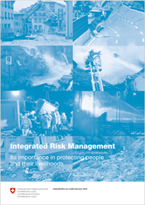 Schweirerische Eidgenossenschaft
Schweirerische Eidgenossenschaft
Sinopse: The increasingly networked nature of modern society, rising dependency on critical infrastructures, high concentrations of assets, and a growing population mean that disasters and emergency situations are causing ever more damage. Mounting risks must be reduced to an acceptable level in a balanced process which systematically identifies hazards, evaluates the risk associated with them, and assesses their acceptability. Risks which are deemed unacceptable must be reduced with appropriate measures. A certain level of residual risk is unavoidable, however, and has to be accepted.
Integrated risk management (IRM) is a central element in many of the risk-oriented planning guidelines used by the Federal Office for Civil Protection (FOCP). It is also applied by other federal offices, cantons and organisations, and is described in a variety of publications. However, the term “integrated risk management” has become a buzzword in recent years, and has lost some of its original meaning.
Frequently, integrated risk management is used only in connection with the cycle of measures that is depicted in the diagram on the right. However, this fails to cover the aspects and meanings of the concept that are not shown explicitly in the diagram.
This document explains the different components and aspects of integrated risk management means. It is intended to support a better understanding of its meaning and its relevance to different areas. The document is aimed primarily at civil protection representatives in charge of disaster and emergency response measures, i.e. decisionmakers, members of staff organisations, representatives of partner organisations, and specialist units.
